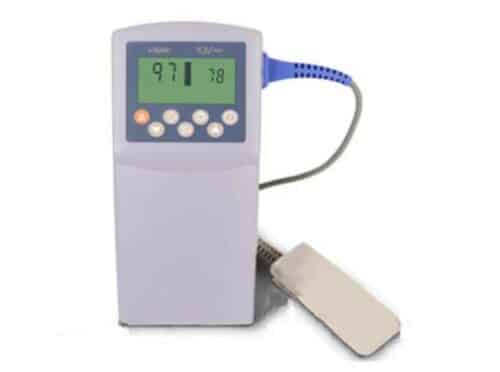Based on the Renesas RL78/G13 microcontroller, the pulse oximeter design includes external hardware, signal processing, and connectivity options for enhanced functionality.

Pulse oximetry, a critical tool in patient monitoring, integrates photoplethysmography and spectrophotometry to measure arterial blood oxygen saturation noninvasively. This advanced technology offers safe, continuous, and cost-effective bedside monitoring of blood oxygen levels. Widely adopted in clinical settings, pulse oximeters are essential in intensive care units for monitoring oxygen saturation and preventing hypoxemia. They also play a vital role in various medical procedures such as bronchoscopy, endoscopy, cardiac catheterization, exercise testing, and sleep studies. They are routinely used in labour and delivery to monitor mothers and infants. The device, typically attached via a finger probe, accurately measures the oxygen content in the patient’s bloodstream.
The reference design for the pulse oximeter from Renesas is based on the RL78/G13 16-bit microcontroller. However, additional external hardware is necessary to meet a pulse oximeter’s specific requirements. An external LCD display controller is added since the microcontroller lacks an integrated display controller. Additionally, the DAC needed to operate the LED driver is implemented externally. For wireless connectivity, a Zigbee or Bluetooth module can be connected to the microcontroller via the high-speed CSI port, enhancing its functionality for the application.
The RL78/G13 device comes equipped with a built-in hardware MAC function, facilitating the implementation of sophisticated signal processing algorithms that minimize artefacts in SpO2 measurements. Additionally, it possesses on-chip data flash, which helps implement the Look-Up Table (LUT) functionality necessary for a pulse oximeter. Constructing a pulse oximeter using the RL78/G13 and an external high-performance analogue front end (including a 12-bit ADC) makes it an excellent option for high-performance applications in ambulatory and hospital market sectors.
The firmware for a pulse oximeter includes drivers that precisely control the LED and IR-LED, manage signal acquisition from the probe, process and compute signals, and display results on an LCD, as illustrated in Figure 7. Additionally, this firmware is responsible for storing computed SpO2 values in the data flash for future access. Power management software is a critical component given the necessity for low power consumption. Furthermore, an optional communication driver can be incorporated to enable connectivity with other devices through USB or wireless.
Renesas has tested this reference design. It comes with a Bill of Material (BOM), schematics, etc. You can find additional data about the reference design on the company’s website. To read more about this reference design, click here.








